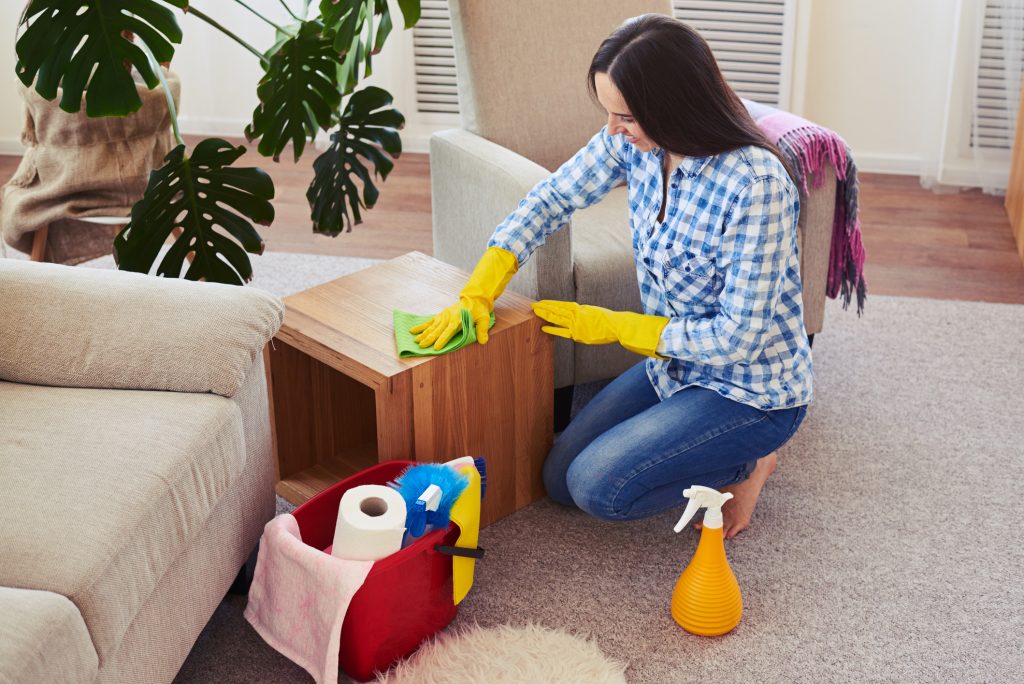You might be surprised how many harmful substances exist in your home. Of course, tobacco smoke is the most harmful, but other risk factors at home include:
- Chemical fumes
- Spray products
- Dust and dirt
- Bacteria
- Mold and mildew
- Household cleaners
- Bug sprays
- Fireplace smoke
Download Risk Factors At Home – Identify and Reduce Them as a PDF.
Common substances found in your home (cleaning products, soaps, deodorants, and cosmetics) can cause lung symptoms by their irritant effect, and can sometimes make asthma worse.
Take a closer look at risk factors at home
Fumes and Particles
Fumes and particles can come from almost anywhere:
- Kitchen
- Bathroom
- Workroom or garage
- Unvented kerosene heaters
- Gas heaters
- Fireplaces
- Wildfires
- Dusts
- Construction or building material (like particleboard and plywood, textiles, and carpets)
Tips to reduce your risk from fumes and particles
- Wear a mask if you’re around smoke or dust.
- Open windows and increase ventilation when you are in areas where fumes may collect from within your home. You may want to install exhaust fans, too. Remember to inspect and clean them regularly.
- Close windows to keep agents outside your home when the irritating agents are coming from the outside (like wildfires).
- Open the garage door when you’re working on your car in the garage. This keeps exhaust fumes out of your home.
- Take care with solvents. Tightly close containers. Dispose of saturated cloths or rags in sealed containers. Always use a mask and gloves when handling these substances.
- Check carpets and carpet pads. Make sure they have very little or no formaldehyde.
Household cleaning products and insecticides
These products can hurt your lungs and your liver. Use them with care.
- Ammonia-based products
- Petroleum-based products
- Oven cleaners
- Bleach and ammonia
- Spray furniture polish
- Bug sprays
- Spray paint
- Mildew remover sprays
Dust and dirt
These build up quickly and can cause breathing problems.
Helpful tips to reduce your risks from dust and dirt:
- Avoid dusty situations, like shaking rugs, vacuuming, sweeping, and dusting. In such situations, consider wearing a mask.
- Use a damp rag or mop to reduce airborne particles.
- Clean household appliances regularly, including:
- Dryer filters
- Refrigerator coils
- Drip pans
- Heat exchangers
- Furnaces
- Heating ducts & vents
- Replace the filters on your air conditioners and heaters
- Use HEPA (High-Efficiency Particulate Air) filters in your home. They’re the best at filtering out small particles.
Smoke from fireplaces and wood-burning stoves
Smoke can be a risk factor for people with breathing problems.
Helpful tips to reduce your risks from smoke:
- Clean your chimney every year, or more if needed.
- Open the damper before lighting the fireplace.
- Burn firewood only. Paper, charcoal, and other items can cause toxic fumes.
- Be sure your wood stove is in proper working condition.
- Gas fireplaces generate little, if any, smoke.
Bacteria, mold, and mildew
These can build up in areas in the home that are moist, damp, and dark. This includes
- Bathrooms
- Kitchens
- Basements
- Garages
- Humidifiers and dehumidifiers
- House plant soil
Helpful tips to reduce your risks from bacteria, mold, and mildew:
- Use fans to increase ventilation in bathrooms and kitchens. Make sure fans vent to the outdoors.
- Wash tile and grouted surfaces frequently, re-grout as needed.
- Wash and replace bath and kitchen sponges frequently, especially during cold and flu season. You can wash them in the washing machine or just soak them in bleach.
- Replace soiled hand towels with fresh ones routinely.
- Seal leaks and waterproof basements. Wipe up leaks and standing water as soon as possible.
- Clean humidifiers and dehumidifiers regularly.
- Empty water trays in air conditioners, dehumidifiers, and refrigerators frequently.
- Clean and dry water-damaged carpets, or remove and replace them altogether.
Where’s the best place to live?
Many individuals with Alpha-1 are concerned about how a specific geographic location will affect their overall health, and whether moving might help their breathing. There is no “best” place to live.
What works for you can have to do with the altitude, local vegetation and pollens, humidity, temperature, and a group of unknowns regarding a given location. If moving is necessary or desirable, the best plan is to live temporarily in the location of your choice for an extended period and see how you do.
For more in-depth information on this topic, please visit the Big Fat Reference Guide. If you are enrolled in AlphaNet’s Subscriber Portal, you can access the BFRG here.
Download Risk Factors At Home – Identify and Reduce Them as a PDF.

